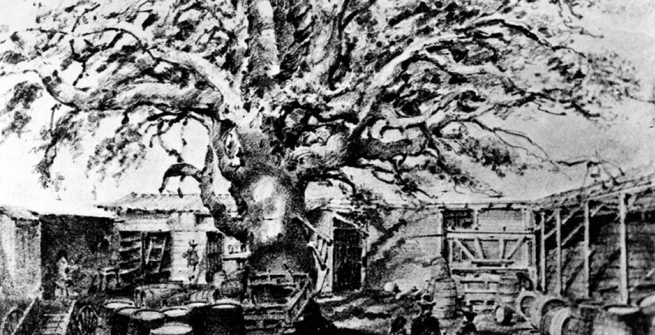“Poems are made by fools like me, but only God can make a tree.”
—Trees by Joyce Kilmer

Hard as it might be to imagine now, a majestic tree once stood on this forlorn strip of concrete wedged between Commercial Street and the 101 Freeway.* The tree, a sycamore, was over sixty feet tall and visible for miles around.
The sycamore tree was venerated by the indigenous Tongva people. They held meetings under the “council tree” and used it to figure distances. Traders used it as a landmark and guidepost. When Los Pobladores, the small band of Spanish settlers who founded Los Angeles, arrived in 1781, they set up camp under its shade. They called the tree “El Aliso,” Spanish for sycamore.
In the 1830s, Frenchman Jean-Louis Vignes bought the land surrounding the tree and opened the El Aliso winery with cuttings he imported from Bordeaux.

Vignes was so fond of the tree that shaded his wine cellar, he became known as “Don Luis del Aliso” to neighbors and townsfolk.

In 1870, the Los Angeles Star described “the big tree of Los Angeles” at the height of its splendor:
“For regularity and symmetry it has no equal in all the country around, and its graceful branches spreading across a diameter of nearly two hundred feet, afford a shade unlike any other in all Southern California…Four feet from the ground the trunk measures twenty feet in circumference, exclusive of the bark, which is two inches in thickness.”
In 1875 the Vignes family sold the winery to German immigrants who opened the Philadelphia Brewing Company. Joseph Maier and George Zobelein purchased the brewery seven years later. The area beneath the tree became a popular beer garden and picnic spot. As the business grew, Maier and Zobelein looked to expand the facility. They built around the tree on three sides, severely pruning the branches on all sides but the one facing Aliso Street.

Within a year, the tree stood “leafless, bleak, and dead.” Though it had survived floods, fires, and the great drought of 1862-1864, El Aliso could not withstand the encroachment of urban development.
The brewery co-owners disagreed on what to do with the lifeless tree. Joseph Maier had wanted to chop the tree down for years, but George Zobelein was reluctant to have the tree removed. For three years the bare trunk stood forlornly in the courtyard.
In 1895 local lumberjack William Willoughby was hired to chop El Aliso down. People came from all over the city to witness its demise and to get chips of the tree for souvenirs. The Chamber of Commerce retained a slice for display and the Los Angeles Herald, “urged the Historical Society of Southern California to have the tree photographed for the benefit of posterity.” Mr. Zobelein refused to take a turn at swinging the ax. He “felt too mournful over the fate of his old pet to strike any of its death blows.”
A young bystander by the name of Charles Gibbs Adams counted 400 rings on the tree stump, giving the tree a lifespan of four hundred years. Adams would grow up to become one of the southland’s first landscape architects, designing the Virginia Robinson Gardens in Beverly Hills and co-designing the Los Angeles County Arboretum in Arcadia.
Though there is no plaque or monument to mark its location, El Aliso is commemorated in the downtown street that bears its name and in the artwork adorning the Division 13 Bus Maintenance and Operations Facility located at the corner of Cesar E. Chavez Avenue and Vignes Street, just a stone’s throw from the spot where the tree stood for 400 years. Artist Christine Ulke’s art installation celebrates the iconic tree with graphite drawings on translucent panels that are particularly resplendent at night.

Today being Arbor Day, let’s take a moment and celebrate El Aliso, the towering sycamore tree that bore witness to the early history of Los Angeles for 400 years.
*Credit goes to author and landscape architect John Crandell for researching and identifying the location of El Aliso.
